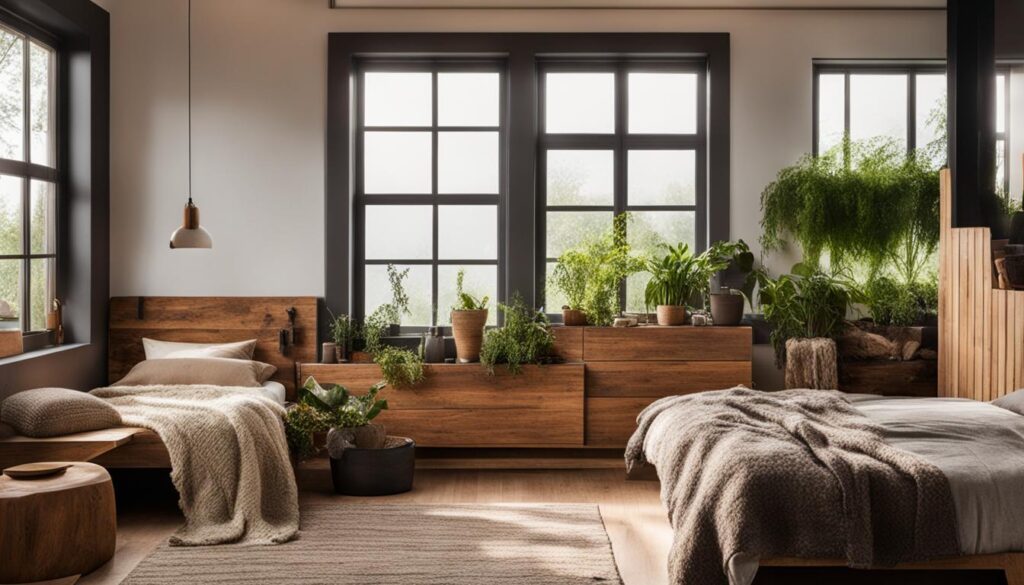As I explore the realm of sustainable home decor, I’m continually inspired by the harmony of style and responsibility. My journey into eco-friendly home furnishings has shown me that ethical interior design does not sacrifice aesthetics for ethics. It’s truly a fusion of both. By integrating environmentally conscious home decoration into my space, I’ve found a profound sense of fulfillment knowing each piece adds to a sustainable future. Whether it’s using green living room accessories or selecting decor that tells a story of preservation, each choice reflects a personal commitment to our planet.
Key Takeaways
- Sustainable home decor seamlessly blends style with environmental accountability.
- Eco-friendly home furnishings offer a stylish approach to ethical interior design.
- Opting for environmentally conscious home decoration contributes positively to our planet.
- Using green living room accessories can enhance aesthetics while promoting sustainability.
- The choices we make in home decor can reflect our commitment to Earth’s future.
The Essence of Sustainable Home Decor
As I delve deeper into the world of interior design, I’ve come to recognize that the essence of sustainable home decor goes far beyond aesthetics. It’s a lifestyle choice that incorporates both eco chic interiors and a commitment to the environment. By selecting sustainable furniture and complementing it with organic home textiles, I create a living space that not only looks good but also feels good.
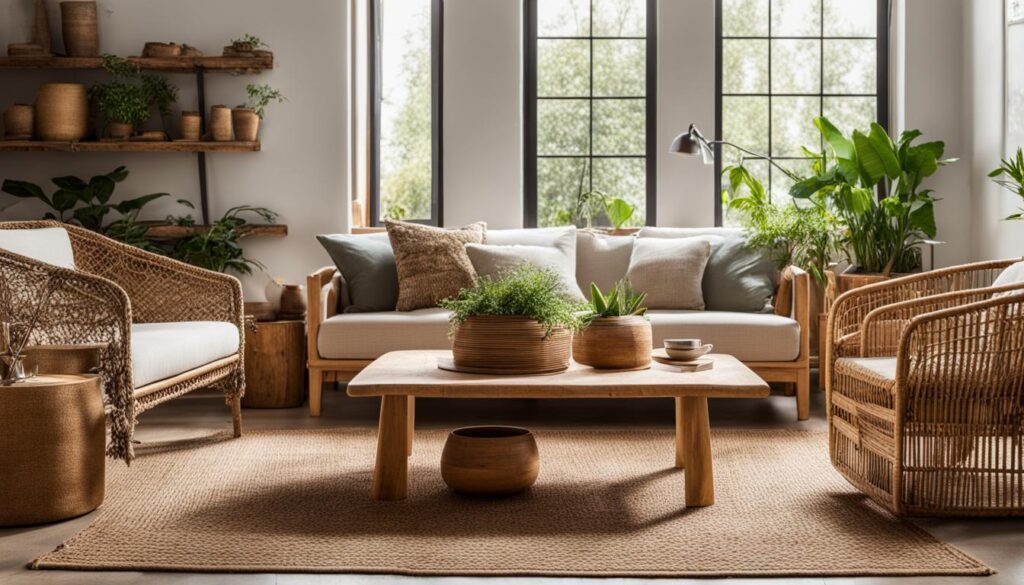

What Makes Decor Sustainable?
For me, a piece of home decor is not just a tangible item but a manifestation of my values. Sustainable pieces, such as those crafted from reclaimed wood or bamboo, offer a resilient yet earth-friendly charm. They honor the planet by minimizing waste, promoting the use of renewable resources, whilst aligning perfectly with an eco chic design vision. Plus, opting for upcycled home accents lets me treasure the beauty in second chances, giving older items a new lease on life.
Benefits for the Environment and Your Health
The benefits of embracing natural home decor extend far beyond the visual aspects. This approach profoundly impacts our planet by reducing carbon footprints and resource consumption. For my health, it’s important to surround myself with materials that are non-toxic and biodegradable, ensuring the air within my sanctuary stays as pure as nature intended. The conscious selection of sustainable items truly reflects my dedication to not just a stylishly furnished home but a thriving, healthy environment as well.
The Impact of Sustainable Materials on Home Design
We’re witnessing a profound transformation in home decor, with the embrace of sustainable interior design influencing every detail from the materials we choose to the furniture we cherish. As I journey through the world of green home decor, I’ve found that the dedication to sustainability is more than a trend; it’s an ongoing commitment to our planet’s future and our own well-being.
Renewable Resources and Biodegradability
What excites me most about sustainable decor is the innovative use of renewable resources that not only enhance our homes but also promise a better tomorrow. It’s about understanding the lifecycle of our possessions, from their origin as raw materials to their ultimate biodegradability. By choosing decor that prioritizes these renewable sources, I’m taking a stand for the environment, piece by beautiful piece.
- Bamboo products that grow quickly and need minimal resources.
- Recycled glass that shimmers with a story of transformation.
- Metals salvaged with care, ready to begin anew in my living space.
High-Quality Sustainable Furnishings
When I look for furniture, I search for pieces that tell a tale of ethical craftsmanship. I prioritize fair trade home decor and support sustainable home brands that share my values. High-quality, durable furnishings not only reduce my ecological footprint but also create an enduring legacy within the walls of my home.
- Durable sofas made from upcycled materials ensure comfort doesn’t cost the earth.
- Eco-friendly bed frames become a restful sanctuary for both me and the environment.
- Reclaimed wood tables bring history and resilience to family dinners.
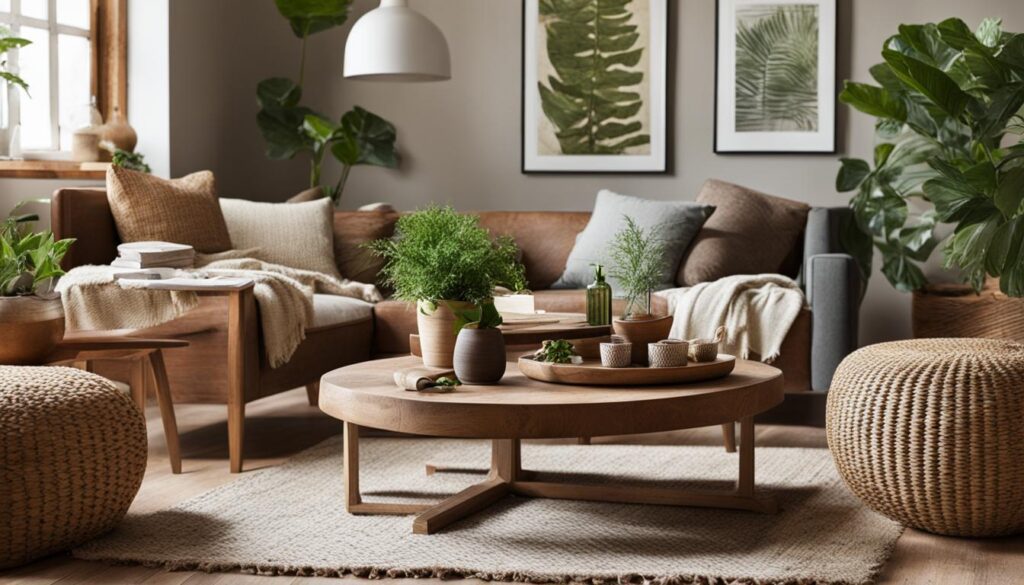

Championing Local Artisans and Craftsmanship
When I think about redecorating my space, I’m not just looking for eco-friendly home decor, I’m aiming to make each item tell a story. That’s why I turn to local artisans and their incomparable skills. It’s a deeply satisfying experience to find pieces that are not only beautiful and unique but also uphold the values of sustainable decoration. There’s a charm in knowing that my choice echoes my commitment to ethical home goods and supports sustainable home goods brands.
- Visiting local craft fairs, I connect with the story behind every handcrafted vase or woven throw. It’s here that I discover the sheer variety of sustainable options available right under my nose.
- I love to frequent nearby vintage shops where each item, from reclaimed wood furniture to retro home accessories, adds to the character of my home without burdening the planet.
- By opting for locally made goods, I take pride in reducing my carbon footprint, since these items travel far less distance to reach me than their mass-produced counterparts.
- There’s a sense of community when I choose local craftsmanship. It feels like I’m not just decorating my home but also nurturing the economy close to home.
It’s not just a matter of decor for me; it’s about being a part of a movement that champions eco-friendly home decor and ensures a greener future for our neighborhoods. And by sharing these finds with you, I hope I can inspire you to do the same.
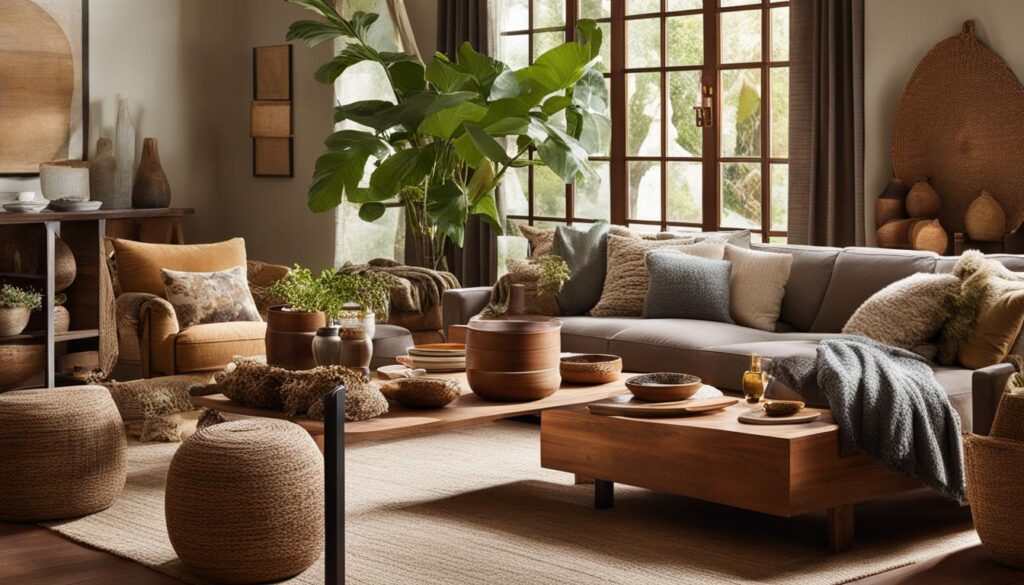

Shining a Light on Solar Energy in Home Decor
As I delve into the world of sustainable home decor brands, I’m consistently drawn to innovative ways to promote eco home decor and sustainable living. It’s thrilling to see how solar energy is seamlessly merging with interior aesthetics, fostering an environmentally friendly home decor movement that’s gaining momentum. Let’s explore the sun-soaked possibilities that are brightening our homes in more ways than one.
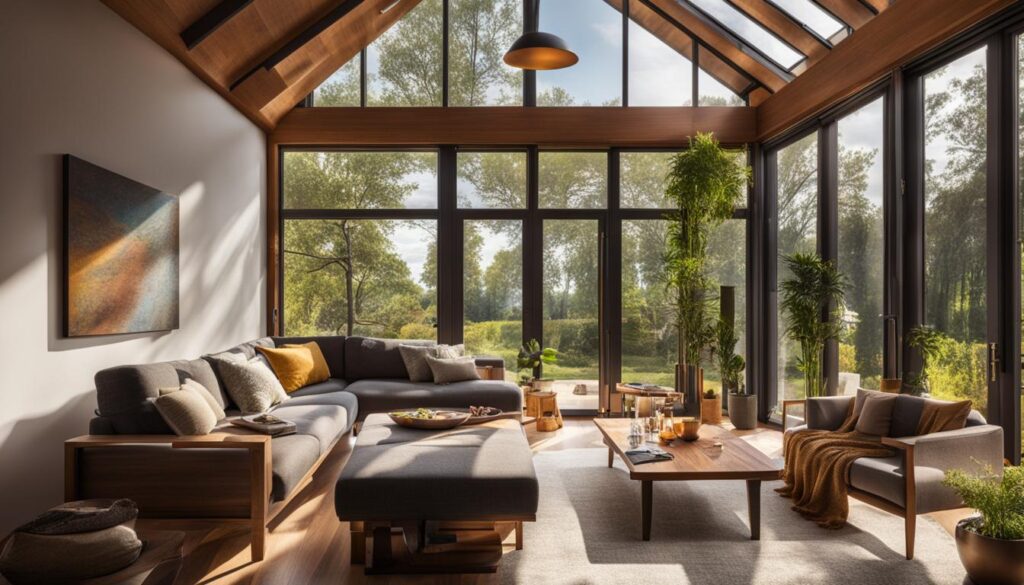

The adoption of solar technology in residences is no longer confined to just rooftop installations. I’ve noticed that solar-powered decor elements are becoming a practical choice for homeowners who are conscious about their energy consumption and environmental impact. From elegantly designed solar panel window blinds to garden lights and illuminated house numbers, solar energy is finding its way into our homes, one sunny innovation at a time.
- Solar-Powered Lamps and Lanterns: Ideal for creating an ambient atmosphere without any electrical wiring, perfect for portability and outdoor spaces.
- Motion-Sensor Solar Lights: Offering both security and efficiency, these fixtures light up automatically, ensuring that energy is used only when necessary.
- Integrated Solar Furniture: Designers are crafting tables and patio furniture with embedded solar panels, which can charge your devices or power LED lights after dark.
Not only are these solar solutions harnessing renewable energy to reduce our reliance on fossil fuels, but they’re also financially savvy in the long run—cutting down on electricity bills and potentially increasing home value. It excites me to witness such a meaningful intersection between form and function, where sustainable home decor brands meet the need for stylish yet environmentally friendly home decor.
I’m committed to this journey of sustainable living, and it’s clear that innovation in home decor isn’t just about visual appeal—it’s a powerful statement about the energy decisions we make for our future. Solar energy in decor is a conversation starter, an opportunity for me to share with my friends and family why choosing eco-friendly options matters.
Houseplants: A Breath of Fresh Air in Eco-Decor
As someone deeply invested in eco-conscious home decor, I’ve learned that houseplants are more than just decorative items. They are natural allies in creating a healthier home environment. By absorbing carbon dioxide and releasing oxygen, they naturally purify the air we breathe. But the benefits extend beyond air quality—houseplants contribute to a serene and vibrant atmosphere, embodying the essence of green living accessories.
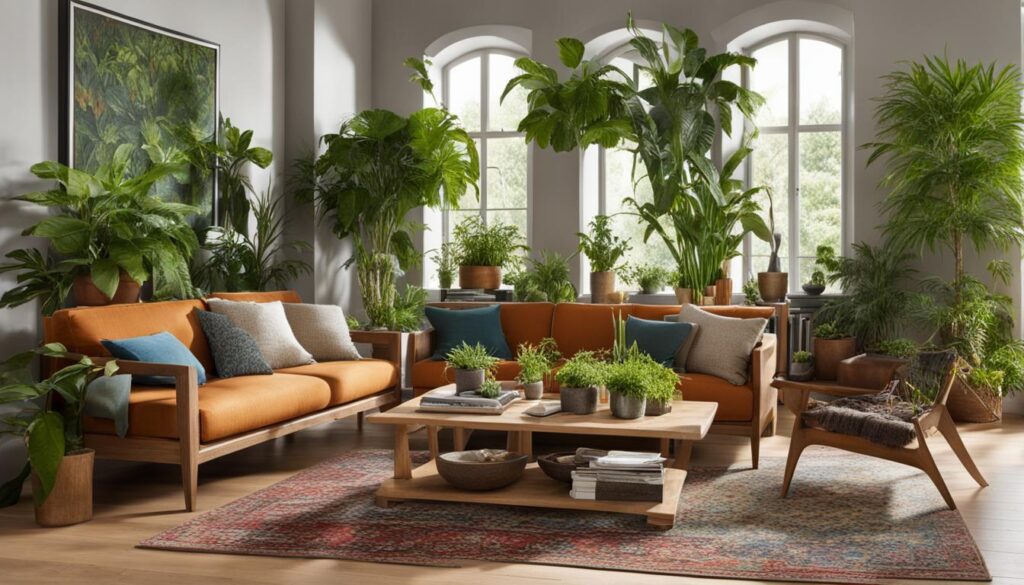

Improving Indoor Air Quality
Integrating plants into my living space has given me an immediate sense of fresh air and vitality. I chose foliage from fair trade home goods stores, ensuring that my green companions are not only beneficial for my surroundings but also ethically sourced. The peace of mind that comes with supporting fair trade practices adds to the overall sense of well-being in my home.
Adding Botanical Style to Your Space
When it comes to home aesthetics, the versatility of plants is unmatched. They can add character to any room, whether it’s through a large potted fiddle leaf fig as a statement piece or a collection of small succulents on a bookshelf. Working with organic cotton decor elements like macramé plant holders also helps me keep my space aligned with sustainable values. Each choice towards a more eco-friendly home brings me closer to the green utopia I envision.
Enlightening Your Space with Energy-Efficient Lighting
When I consider enhancing my living environment, I’m struck by the notion that the most brilliant solutions are often the simplest. Transitioning to energy-efficient lighting, such as LEDs and CFLs, stands out not just for its ease but also for being profoundly aligned with eco-friendly decor. These aren’t just lighting options; they’re decisions that reflect my commitment to ethical home decor. Let me share with you how natural light and energy-efficient products can illuminate our homes in an eco-conscious light.
There’s an inherent charm in the way sunshine spills across a room, isn’t there? Reorienting my home to capture more natural light not only reduces my electrical usage during the day but also promotes a serene and healthy living space. Such a strategy goes hand-in-hand with picking out lighting fixtures and bulbs that carry the promise of sustainability. Here are some steps I take to ensure that my lighting choices stay true to my values:
- Examining Efficiency Ratings: Before purchasing, I always check the lumens-per-watt rating to guarantee I’m choosing the most energy-efficient bulbs.
- Integrating LEDs: LEDs are a fantastic innovation in energy savings, with bulbs that last longer and are mercury-free, unlike their CFL counterparts.
- Utilizing Dimmers and Sensors: Implementing dimmer switches and motion sensors means lights are on only when necessary, curbing wasteful consumption.
Every choice, from the simplest light bulb to the grandest chandelier, contributes to the collective effort towards sustainability. I’ve found joy in selecting fixtures made from natural home accessories such as recycled glass or repurposed items, feeding both my aesthetic and environmental consciousness.
- I favor fixtures that complement natural light during the day and provide warm, ambient lighting at night.
- Choosing table and floor lamps that showcase biodegradable shades partners function with sustainable design beautifully.
- Smart home technology has also found its way into my home, offering the convenience of controlling lighting remotely, thus further economizing on energy usage.
It’s empowering to illuminate my home thoughtfully, knowing that each switch flipped furthers a greener tomorrow. By adopting energy-efficient lighting, I am taking a small, yet significant, step in creating a home that’s as eco-friendly as it is welcoming.
Natural Home Aesthetics: Paints and Stains with Low VOCs
Transforming my home into a sanctuary of well-being is always on my agenda. It’s not just about how the decor looks; it’s also about ensuring that every facet of my space contributes to a safe and healthy environment. In the journey toward embracing non-toxic eco-friendly home furnishings, I’ve learned that every choice, from furniture to the very paints on my walls, impacts my indoor air quality and overall health.
The Health Effects of VOCs in Traditional Paints
I’ve made an unsettling discovery about conventional paints—they’re riddled with volatile organic compounds (VOCs) known to release harmful chemicals into the air long after application. These toxins can lead to a myriad of health issues, ranging from headaches and dizziness to more chronic respiratory problems and even organ damage over prolonged exposure.
Choosing Environmentally Friendly Paint Alternatives
Embarking on a quest for safer alternatives, I’ve turned to low-VOC and zero-VOC paints and finishes. They promise a breath of fresh air by significantly reducing indoor pollution. These low-VOC home products are vital to my commitment to sustainable living and safe home decor choices, ensuring the air inside my home remains as pure as possible.
- Invest in non-toxic brands that are transparent about their ingredients.
- Look for certifications that back up environmental claims.
- Consider natural paints that use water as a solvent or those based on lime, clay, or milk proteins.
- Remember that even natural ingredients can have odors, so proper ventilation during painting is a must.
By selecting the right eco-friendly home products, I’m contributing to a healthier planet and creating a safe haven for myself and my family. It’s a testament to how small changes can make a big difference, not just aesthetically but in the air we breathe and the world we live in.
Cotton-Based Decor: Soft Touch, Lasting Impact
When I think of transforming my living space into a sustainable sanctuary, my mind often wanders to organic home textiles. Envision the delicate weave of a cotton-based throw or the soft embrace of a pillow crafted with care—these are the pieces that bring solace and sustainability to our homes. Sustainable home goods aren’t just about being trendy; they’re about making choices that have a gentle footprint on the earth and a lasting touch in our hearts.
As someone avidly seeking eco-friendly home accents, I’ve learned that the journey starts with materials that benefit both our personal space and the planet. Let’s delve into why cotton decor stands as a testament to both comfort and eco-responsibility.
The Longevity and Biodegradability of Organic Textiles
One might ask, “Why cotton?” Well, the answer lies in its enduring nature—organic cotton offers a resilience that withstands the test of time, fostering a longer life cycle for my cherished home essentials. These aren’t just decorative elements; these are heirlooms in the making, passed down as tokens of our environmental consciousness. Beyond longevity, the advantage of cotton is its quiet return to the earth, fully biodegradable, eschewing the permanent legacy of synthetics. It gives me peace of mind, knowing my choices today won’t haunt the landscapes of tomorrow.
Supporting Sustainable Farming Practices
Each time I choose a cotton blanket or a set of curtains, I see it as casting a vote for sustainable farming practices. It’s a choice that says “no” to harsh chemicals and “yes” to preserving the integrity of our soil and water. The farmers who adopt these practices deserve our support. Choosing fair trade home decor reinforces a chain of positivity that extends from seed to sanctuary. Through this, I become part of a larger narrative: one that weaves the story of a healthier, more equitable planet where every purchase aids in cultivating a greener future.
- Embrace organic textiles for a cozy, yet eco-conscious home vibe.
- Invest in cotton-based decor with the confidence of its biodegradability.
- Support farmers and artisans dedicated to fair trade and sustainable processes.
In my personal exploration of greener living, the voyage with cotton has been enlightening. From the tactile joy it brings to my living space to the positive environmental ripples it creates, this is home decor with a deeper impact. I’m not just outfitting my abode; I’m nurturing a philosophy of life that respects and cherishes our shared home—Earth.
Rejuvenating Interiors Through Upcycled Home Accents
As someone deeply committed to sustainable living, I’ve found that one of the most gratifying ways to enhance my home environment is by integrating upcycled home accents. The process is inherently creative, converting what might have been waste into eye-catching and functional pieces. Not only does this help to minimize my carbon footprint, but it also adds an unparalleled charm and character to my space. According to the U.S. Environmental Protection Agency, or EPA, the impact of such practices extends far beyond the confines of my home by significantly reducing the volume of discarded items and waste.
Sustainable furniture isn’t just about buying items made from renewable resources; it’s also about repurposing and rejuvenating the old. Whether it’s a vintage chest of drawers that’s been in the family for years or a flea market find that’s seen better days, a little creativity and elbow grease can transform these pieces into something new and exciting.
The thrill of eco-friendly home decoration comes with the knowledge that I’m not contributing to the cycle of buy and dispose. Upcycling allows for the old to be new again, not only conserving resources but also telling a story through the home decor. It’s about embracing the scratches and the dents and seeing the beauty in imperfection.
Through this article, I want to share with you some of the ways I’ve been able to incorporate upcycling into my home:
- Reupholstering Vintage Chairs: Giving a new lease of life to worn-out seat coverings can make an astonishing difference. Fabric samples, old curtains, and even clothes can provide unique and personalized touches.
- Repainting Old Shelves: A simple coat of paint can refresh an outdated shelf. By choosing a low-VOC or milk paint, you stay true to eco-friendly principles while updating your storage solutions.
- Transforming Jars and Bottles: Glass containers can become planters, vases, or even chandeliers. It’s a subtle nod to sustainable practices and adds a quirky yet chic element to any room.
As I continue on my journey towards a more sustainable lifestyle, I encourage you to look around your own home. See the potential in items that may have otherwise been discarded. Consider the ways in which they can be given new purpose, and join me in creating beautiful and sustainable environments that don’t compromise on style.
Conclusion
As we journey through the realms of interior design, it’s evident that our individual choices in home decor reflect not only personal style but also our values and commitment to the planet’s welfare. The path I’ve explored throughout this article underscores the transformative power of sustainable decoration as both a personal and collective endeavor. Proactively selecting green home accessories and making ethical decor choices transcends superficial trends, cementing a legacy of environmental stewardship within the sanctuary of our homes.
The Path Forward with Sustainable Home Decor
Embracing the sustainable home decoration journey has never been more imperative. With each bamboo frame, recycled glass vase, or energy-efficient light fixture, I’m contributing to a demand for products that honor and preserve natural resources. This wave of eco-consciousness is reshaping the industry as I’ve observed through the lens of numerous eco-friendly brands that are meeting this call with innovative, responsible designs.
Why Your Choices Matter
The look and feel of my living space can indeed coexist harmoniously with the Earth’s needs. By choosing home decorations that align with ethical production and sustainable practices, we collectively forge a path of lesser impact. My actions, reinforced by like-minded individuals, ripple through the fabric of society, influencing market trends and, ultimately, the environmental legacy we leave behind. It’s within our grasp to cultivate homes that celebrate both our uniqueness and our unwavering respect for this blue planet we call home.
FAQ
What is sustainable home decor?
Sustainable home decor refers to items used for decorating a home that are made from eco-friendly, renewable, or recycled materials. These products are designed to minimize environmental impact by reducing waste, avoiding toxic substances, and often supporting fair trade practices.
Why should I choose eco-friendly home furnishings?
Opting for eco-friendly home furnishings can have a positive impact on the environment by conserving natural resources, reducing pollution, and minimizing your carbon footprint. Additionally, these furnishings can improve your indoor air quality and contribute to a healthier home environment.
How does ethical interior design benefit my health?
Ethical interior design focuses on using non-toxic and natural materials, which can significantly reduce your exposure to harmful chemicals often found in conventional home decor. This can improve air quality in your home and protect your health from potential irritants and allergens.
What materials are considered sustainable for furniture and decor?
Materials like bamboo, reclaimed wood, organic cotton, recycled glass, and metal are considered sustainable. They are renewable, biodegradable, and generally have a lower environmental impact compared to traditional materials.
Can sustainable interior design still be stylish?
Absolutely! Sustainable interior design often leads to unique and beautiful pieces that are as stylish as they are eco-friendly. With a focus on craftsmanship and natural beauty, sustainable decor can elevate the aesthetic of any living space.
What are the benefits of choosing high-quality sustainable furnishings?
High-quality sustainable furnishings are not only crafted to last longer, reducing the need for frequent replacements, but they also tend to have a timeless design that transcends passing trends, which means you’re investing in pieces that you can cherish for a longer time.
Why should I support local artisans and sustainable home goods brands?
Supporting local artisans and sustainable home goods brands helps to stimulate the local economy, encourages traditional craftsmanship, and reduces the carbon footprint associated with the mass transportation of goods. It also ensures that you’re investing in ethical home goods.
How does incorporating solar energy contribute to a sustainable home?
Incorporating solar energy through items like solar panels can reduce your reliance on non-renewable energy sources, decrease your electricity bills, and may increase the value of your home. It’s a clean energy source that complements sustainable living principles.
How do houseplants improve indoor air quality?
Houseplants can improve indoor air quality by absorbing toxins and producing oxygen. They act as natural air purifiers, making the air in your home purer and healthier to breathe while enhancing your decor with their vibrant life.
What is the importance of energy-efficient lighting in sustainable decor?
Energy-efficient lighting, such as LED and CFL bulbs, consumes less energy and lasts longer than traditional bulbs. This helps to reduce your electricity consumption, lower energy bills, and decrease your overall environmental footprint.
How do low-VOC paints contribute to a natural and healthy home environment?
Low-VOC paints minimize the release of volatile organic compounds, which are harmful to both the environment and your health. Choosing these paints helps create a safer living space with better air quality.
Why is it beneficial to choose cotton-based decor?
Cotton-based decor like blankets and rugs made from organic cotton is sustainable as it is biodegradable and often produced with fewer pesticides and chemicals. It’s a comfortable, durable choice for eco-conscious consumers.
How does upcycling benefit sustainable home decoration?
Upcycling transforms existing materials and products into new decorative items, which reduces waste and prevents the need for additional resources in manufacturing new goods. It also often results in unique, one-of-a-kind pieces for your home.

